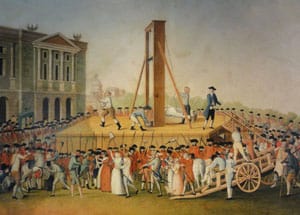The title of this 132nd episode is “Off with Their Heads.”
In this installment, we give a brief review of the French Revolution, which may not seem at first blush to have much to do with Church History. Ahh, but it does. For this reason: What we see in the French Revolution is a proto-typical example of the Church, by which the institutional church, not necessarily the Christian Gospel and Faith, collided with Modernity.
Some astute CS subscribers may take exception to this, but I’ll say it anyway è In the French Revolution we see the boomerang of the Enlightenment that sprang FROM the Renaissance, come back round to give the Church a mighty slap in the face. The Renaissance opened the door to new ways of thinking, which led first to the Reformation, which cracked the Roman Church’s monopoly on religion and made it possible for people to not only believe differently, but to go even further to choose not to believe at all. Rationalism may have ended up agnostic and atheistic, but it didn’t begin there. Some of the first and greatest scientists worked their science in the context of a Biblical worldview, as we’ve shown in previous episodes. And the earliest rationalist philosophers based their work on the evolving theology of Protestant scholastics.
It was during the French Revolution when the dog bit the hand that had fed it. Or maybe better, when the lion mauled its trainer.
The French monarch Louis XVI was a weak ruler and an inept politician. Economic conditions grew worse, especially for the poor, while of the king and his court were profligate in spending. In a desperate need to raise funds, the king convened the Estates General, the French parliament.
It was composed of three orders, three Estates; the clergy, the nobility and the middle-class bourgeoisie. Louis’ advisors suggested he enlarge that Third Estate of the middle class so he could coerce the other two estates of clergy and nobility to comply with his request for more taxes. The ranks of the clergy were then enlarged as well by adding many parish priests to offset the bishops who were largely drawn from the French nobility. These priests were no friend to the nobles.
When the assembly gathered in early May, 1789, the Third Estate had more members than the other two combined. And among the clergy less than a third were nobles. The Third Estate insisted the Parliament function as a single chamber. The Clergy and Nobility were used to operating separately so that there were three votes. They usually united to vote down anything the Third Estate of the Middle class came up with. A row ensued, but when priests sided with middle class members, it was decided things would be decided by a united house and simple majority vote. The nobility balked so Priests and Bourgeoisie formed anew body they called the National Assembly, claiming they were now the legal government and represented the nation. Two days later the entire Clergy joined the National Assembly.
The economy worsened, and hunger was widespread. Fearing what the National Assembly might do, the Crown ordered it to disband and forcibly closed the doors. Its members refused to comply and continued working on a new Constitution. The king moved troops to the outskirts of Paris and deposed a prominent and popular member of the opposition government named Jacques Necker. Parisians expressed their outrage by rioting in a bout of civil unrest that reached a climax on July 14, when they took the Bastille, a fortress that served as an armory, bunker, and prison for those who’d run afoul of the Crown.
From that point on, things moved quickly toward full-fledged revolution. Three days later the king capitulated and recognized the authority of the National Assembly as the new government. The Assembly then issued the Declaration of the Rights of Man and the Citizen, which became foundational to democratic movements in France and other nations. But when Louis reneged and refused to accept the Assembly’s decisions, Paris rioted yet again. The royal family became prisoners in the capital.
The National Assembly then moved to reorganized France’s government, economy, and religion. The most important step in this was the Civil Constitution of the Clergy, put into effect in 1790.
For centuries the French church had been governed by Gallican liberties, protecting it from interference by Rome. French bishops had a buddy-system with the French Throne. But now, with the Crown gutted of authority, the National Assembly assumed the role in the Church the king had played. Recognizing the need for reform, they set to work. A the peak of church hierarchy were members of the aristocracy. These prelates weren’t used to the real work of shepherding God’s flock. Their seat was a matter of income and prestige, pomp and ceremony. Monasteries and abbeys had become private clubs filled with debauchery. Abbots were known, not for their simple homespun smocks and bare feet, but for their excessive luxury and crafty political intrigues.
Some members of the Assembly wanted to reform the church. Others were convinced the Church and the Faith it was supposed to stand as the eternal servant of, was naught but a lot of hog-wash, silly superstition from times long past, and ought now be swept away. Those voices were few at first, but their numbers grew and took the foreground later in the Revolution.
Most of the measures the Assembly proposed aimed at reform of the Church. But the deeper challenge leveled by some was, did the Assembly even have authority to make changes? Since when did the civil government have a say in Church affairs? And hold on – since the Reformation introduced a divide between Protestants and Catholics, which church was being addressed? A suggestion was made to call a council of French bishops. But the Assembly quashed that because it put power back in the hands of aristocratic bishops. Others suggested the Pope be invited to weigh in. But the French were reluctant to surrender their Gallicanism by giving Rome a foothold.
Pope Pius VI sent word to Louis XVI the new Constitution was something he’d never accept. The king feared the Assembly’s reaction if they found out about the Pope’s resistance so he kept it secret. Then, at the insistence of the Assembly, the king agreed to the Constitution, but announced his approval was contingent on the Pope signing off. The Assembly tired of the delay and decreed that all who held ecclesiastical office had to swear allegiance to the Constitution. Those who declined would be deposed.
The Church was divided.
You see, in theory, those who refused were to suffer no more than a loss of office. On the basis of the Assembly’s declaration on rights, they couldn’t be deprived of their freedom of thought. And anyone who wanted to maintain them as their clergy were welcome to do so. But they were on their own. Those who signed on to the new Constitution would be supported by the state. à Again, all that was in theory. In practice, those who refused to swear allegiance were persecuted and branded as dangerous counterrevolutionaries.
Revolutionary movements gained strength across Europe. Such movements in the Low Countries and Switzerland failed, but monarchs and the nobility feared the French movement would spread to other lands. That inspired French radicals to more extreme measures. In 1791, the National Assembly morphed into the Legislative Assembly, with far fewer voices calling for moderation. Half a year later, France went to war with Austria and Prussia—beginning a long series of armed conflicts that continued till the end of the Napoleonic Wars in 1815.
The day after securing victory at the Battle of Valmy, the Legislative Assembly again reformed into the National Convention. In its first session, the Convention abolished the monarchy and announced the French Republic. Four months later, the king was accused of treason, convicted and executed.
But that didn’t put an end to France’s problems. The economy was in shambles in every village, town, and city. Every social class suffered. But the peasants suffered most, as they always do. They revolted. Fear of foreign invasion grew. All this led to a wave of terror where everybody was suspected of counterrevolutionary conspiracies, and many major figures of the revolution were put to death one after another at the guillotine.
Combined with all this was a strong reaction against Christianity, of all stripes. The new leaders of the revolution were convinced they were prophets and engineers of a New Age where science and reason would overcome superstition and religion. They claimed that as the new age was born, time had come to leave behind the silly ideas of the old.
The Revolution created its own religion, called first the Cult of Reason; later the Cult of the Supreme Being. By then the Constitution with its rights for individuals was forgotten. The revolution wanted nothing to do with the Church. The calendar was changed to a more “reasonable” one where a week was 10 days and months were named after nature. Elaborate spectacles were staged to celebrate the new age of reason and new holidays were established to replace the old religious ones. Temples to Reason were built to replace churches, and a list of saints was issued—among whom were Socrates, Marcus Aurelius, and Rousseau. New rites were devised for weddings, funerals and the dedication of children, not to God but to philosophical ideals like Liberty.
As I record this, and you listen, with whatever activity you’re doing, all these radical rationalist ideas may seem ridiculous, in light of their short lifespan. Like demanding everyone suddenly call red blue, and blue is from now on going to be called green. Just because we say so. It would be ridiculous, were it not for the fact they were deadly earnest about it and killed thousands for no more reason than being under suspicion of calling their changes absurd.
“Off with their heads” became a slogan that literally saw people slipped under the guillotine’s blade. Christian worship was supposedly permitted; but any priest who refused to swear before the altar of Freedom was accused of being a counterrevolutionary and sent to the guillotine. Somewhere between two and five thousand priests were executed, as well as dozens of nuns and countless laypeople. Many died in prison. In the end, no distinction was made between those who’d sworn allegiance to the Constitution, those who refused to, and Protestants. Although the reign of terror ended in 1795, the government continued to oppose Christianity. Where ever French troops marched and asserted their presence, their policies followed. In 1798, they invaded Italy and captured Pope Pius VI, taking him to France as a prisoner.
Napoleon, who risen through the ranks of the French army, became ruler of France in November of 1799. He believed the best policy for France was to seek a reconciliation with the Catholic Church, and opened negotiations with the new pope, Pius VII. In 1801, the papacy and French government agreed to a Concordat that allowed the Church and State to work together to appoint bishops. Three years later, Napoleon decided he wanted to be more than just the First Consul of France, and fancied the title “Emperor.” He had Pope Pius officiate his coronation. Then Napoleon turned around and decreed religious freedom for Protestants.
So, Pope and Emperor fell out wit one another and France once again invaded Italy ending with the Pope again in chains. But in his captivity Pius refused to endorse Napoleon’s actions. He was especially critical of his divorce from Josephine. Pius remained a prisoner until Napoleon’s fall, when he was restored to his seat at Rome. There he proclaimed a general amnesty for all enemies, and interceded for Napoleon before his British conquerors.

